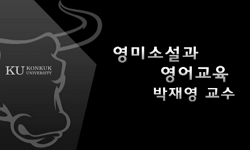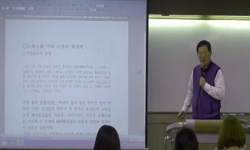본 연구는 오정희 소설 안에서의 시점이 어떠한 역할을 수행하고 있으며 그러한 등장인물의 시점을 통한 소설의 전개 기법이 소설 안에서 어떠한 미적인 효과를 드러내는가를 알아보는 데...
http://chineseinput.net/에서 pinyin(병음)방식으로 중국어를 변환할 수 있습니다.
변환된 중국어를 복사하여 사용하시면 됩니다.
- 中文 을 입력하시려면 zhongwen을 입력하시고 space를누르시면됩니다.
- 北京 을 입력하시려면 beijing을 입력하시고 space를 누르시면 됩니다.
https://www.riss.kr/link?id=T8945349
- 저자
-
발행사항
부산: 경성대학교, 1999
- 학위논문사항
-
발행연도
1999
-
작성언어
한국어
- 주제어
-
KDC
813.604 판사항(3)
-
발행국(도시)
부산
-
형태사항
61장; 26cm
-
일반주기명
참고문헌수록
- 소장기관
-
0
상세조회 -
0
다운로드
부가정보
국문 초록 (Abstract)
첫째, "별사"는 기왕의 오정희 소설 가운데에서는 가장 많은 주목의 대상이 되어온 작품이다. 무엇보다도 사건이 일어난 순서대로의 이야기 시간과 텍스트상에서 재배열된 담화시간 사이의 시간착오에서 야기되는 작가의 서술적 책략을 얼른 알아내기가 쉽지 않았다. 현재시점으로 서술해 나가는 "별사" 전체의 이야기가 기왕의 논자들의 논의와 별반 차이가 없는 회상의 이야기이며, 그럼에도 불구하고 독자들이 이 작품을 주인공의 이야기-현재의 사건으로 인식하게 되는 것이 작가가 의도한 고도의 서술적 책략임을 알 수 있다. 이러한 이중적 시간 구조속에서 "별사"를 지배하고 있는 핵은 바로 죽음의식이다. 그것은 "별사"의 현실을 지배하고 현실마저 죽음으로 몰아가게 한다.
둘째, "어둠의 집"은 시점의 전이에 주목했다. 소설 서두에서 객관적 거리를 지키던 3인칭의 화자가 등화관제가 시작되고 등을 끄는 순간부터 인물의 내면으로 다가서는 내면 초점화 양상이 뚜렷이 나타났다는 것을 알 수 있었다. 이때 불이 꺼짐에 따라 일어나는 의식의 내밀화는 빛의 세계와 어둠의 세계라는 상징적 반전을 일으킨다. 그것은 또한 일상성의 문체에서 의식, 무의식의 세계를 담는 어둠의 문체로 전이되고 서술자와 주인공으로 존재하는 등장인물의 의식이 상호교류하고 혼재되는 국면으로 확산되어 급기야 내적독백으로 치닫는다. <그 여자>는 등화관제가 실시되는 20여 분 간의 짧은 시간 동안 허무적인 자신의 존재적 위상을 발견하게 된다.
세째, "중국인 거리"는 1인칭 복수시점과 단수시점을 번갈아 사용하고 있는데 화자는 완전히 겉에서만 이 인물 저 인물을 비추는 카메라의 시선과 같은 기법을 사용하고 있다. 이상스런 인물들이 유기적인 연결없이 등장하는 인물들의 알 수 없는 행동들을 보면서도 화자는 결코 타인의 마음속을 들여다 볼 수 없는 철저한 비정적 거리를 유지하고 있다. 소설은 이방의 분위기를 바탕에 깔고 유년기적 시점과 비극적 현실이라는 두 축의 화합에 의해 비극은 극복의 양상을 띠고, 시점은 싱싱하게 살아서 과거이면서도 현재적 기능을 수행할 수 있는 것이다.
본 연구는 오정희 소설 안에서의 시점이 어떠한 역할을 수행하고 있으며 그러한 등장인물의 시점을 통한 소설의 전개 기법이 소설 안에서 어떠한 미적인 효과를 드러내는가를 알아보는 데에 바쳐졌다. 소설의 전략적인 측면에서의 시점이란 결국 작가가 이야기하고 있지 않다는 것을 독자에게 믿게하기 위한 조작이다. 여기에서 시점은 단순히 줄거리를 전개시키고 행위를 진전시키는 서술적인 부분에만 관계되지 않는다. 그것은 화자의 설명과 이야기, 그리고 주석을 대신한다. 인물들의 시점을 통한 소설읽기는 독자에게 소설이 의도한 주제와 의미가 무엇인가에 대한 해답을 찾는데에 일역을 한다. 그것은 오정희의 소설이 시점에 대해서 자의식적인 태도를 견지하고 있다는 데에서도 알 수 있다. 또한 인물의 내면적인 의식의 재현과 전달을 주된 문체론적 수단으로 취하고 있는 독특한 서술방식에서도 나타났다.
첫째, "별사"는 기왕의 오정희 소설 가운데에서는 가장 많은 주목의 대상이 되어온 작품이다. 무엇보다도 사건이 일어난 순서대로의 이야기 시간과 텍스트상에서 재배열된 담화시간 사이의 시간착오에서 야기되는 작가의 서술적 책략을 얼른 알아내기가 쉽지 않았다. 현재시점으로 서술해 나가는 "별사" 전체의 이야기가 기왕의 논자들의 논의와 별반 차이가 없는 회상의 이야기이며, 그럼에도 불구하고 독자들이 이 작품을 주인공의 이야기-현재의 사건으로 인식하게 되는 것이 작가가 의도한 고도의 서술적 책략임을 알 수 있다. 이러한 이중적 시간 구조속에서 "별사"를 지배하고 있는 핵은 바로 죽음의식이다. 그것은 "별사"의 현실을 지배하고 현실마저 죽음으로 몰아가게 한다.
둘째, "어둠의 집"은 시점의 전이에 주목했다. 소설 서두에서 객관적 거리를 지키던 3인칭의 화자가 등화관제가 시작되고 등을 끄는 순간부터 인물의 내면으로 다가서는 내면 초점화 양상이 뚜렷이 나타났다는 것을 알 수 있었다. 이때 불이 꺼짐에 따라 일어나는 의식의 내밀화는 빛의 세계와 어둠의 세계라는 상징적 반전을 일으킨다. 그것은 또한 일상성의 문체에서 의식, 무의식의 세계를 담는 어둠의 문체로 전이되고 서술자와 주인공으로 존재하는 등장인물의 의식이 상호교류하고 혼재되는 국면으로 확산되어 급기야 내적독백으로 치닫는다. <그 여자>는 등화관제가 실시되는 20여 분 간의 짧은 시간 동안 허무적인 자신의 존재적 위상을 발견하게 된다.
세째, "중국인 거리"는 1인칭 복수시점과 단수시점을 번갈아 사용하고 있는데 화자는 완전히 겉에서만 이 인물 저 인물을 비추는 카메라의 시선과 같은 기법을 사용하고 있다. 이상스런 인물들이 유기적인 연결없이 등장하는 인물들의 알 수 없는 행동들을 보면서도 화자는 결코 타인의 마음속을 들여다 볼 수 없는 철저한 비정적 거리를 유지하고 있다. 소설은 이방의 분위기를 바탕에 깔고 유년기적 시점과 비극적 현실이라는 두 축의 화합에 의해 비극은 극복의 양상을 띠고, 시점은 싱싱하게 살아서 과거이면서도 현재적 기능을 수행할 수 있는 것이다.
다국어 초록 (Multilingual Abstract)
It can be also seen in the female novelist's unique way of description which adapts reproducing and delivering characters' inner consciousn- ess as her main literary style.
Now I'd like to conclude as follows about novels by Oh, jung-hee evaluated in terms of a point of time.
First, "A farewell speech" has attracted more attention than any other novels by the female novelist. Above all, the time confusion arising between sequential events and rearranged conversations has made it impossible to find out the writer's descriptive intention rapidly. The novel whose descriptive point of time is present is a retrospective story that has not many differences in developing from other existing novels, but the female writer intends to make readers consider a main character's story as an event happening at present. "A farwell speech" whose time structure is dualistic is controlled by consciousness of death. The consciousness also controls the novel's reality and leads it to the end.
Second, I focused on changes in a descriptive point of time with her novel, "A dark house". In the beginning of the novel a third speaker keeps objectivity, but he approaches and apparently focuses on a character's inner mind as control of lights starts and the character turns off the light. A dense consciousness invokes conversion between light and dark worlds as the light becomes off. It also transfers a routine literary style into a dark one which contains the worlds of consciousness and unconsciousness, developing to an aspect in which a descriptor and a character exchanges spiritually and finally leading to an interior monologue. <The woman> as a main character of the novel finds herself as a futile being even during such a short-time blackout.
In "The Chinese road", the female writer uses the first person's dualistic and single descriptive points of time in turn. A speaker sees each of characters separately from the whole outside as if he aims his camera. He thoroughly and cold-heartedly keeps distance from unique characters of the novel without observing their mind, although he sees they appear with no organic connections among them and do behaviors which could not be understood. With an underlying exotic climate, the novel shows a recovery from tragedy under the composition of the time of childhood as the past and a tragic reality as the present. That is, the novel employs a descriptive point of time as the past and simultaneously the present.
The purpose of this study is to examine the role of a descriptive point of time in novels by Oh, jung-hee and aesthetic effects of the point in developing her nevels. From a strategic view, a novel's point of time is used to make readers believe that ...
The purpose of this study is to examine the role of a descriptive point of time in novels by Oh, jung-hee and aesthetic effects of the point in developing her nevels. From a strategic view, a novel's point of time is used to make readers believe that a novelist made a story. It not only relates to descriptive parts such as plot and characters' actions but also represents a speaker's explanation and narrative and notes. Reading a novel based on a descriptive point of time of characters helps readers understand the theme and significance intended by the novel. This can be found in Oh, jung-hee's novels in that her works have a self-conscious position about a descriptive point of time.
It can be also seen in the female novelist's unique way of description which adapts reproducing and delivering characters' inner consciousn- ess as her main literary style.
Now I'd like to conclude as follows about novels by Oh, jung-hee evaluated in terms of a point of time.
First, "A farewell speech" has attracted more attention than any other novels by the female novelist. Above all, the time confusion arising between sequential events and rearranged conversations has made it impossible to find out the writer's descriptive intention rapidly. The novel whose descriptive point of time is present is a retrospective story that has not many differences in developing from other existing novels, but the female writer intends to make readers consider a main character's story as an event happening at present. "A farwell speech" whose time structure is dualistic is controlled by consciousness of death. The consciousness also controls the novel's reality and leads it to the end.
Second, I focused on changes in a descriptive point of time with her novel, "A dark house". In the beginning of the novel a third speaker keeps objectivity, but he approaches and apparently focuses on a character's inner mind as control of lights starts and the character turns off the light. A dense consciousness invokes conversion between light and dark worlds as the light becomes off. It also transfers a routine literary style into a dark one which contains the worlds of consciousness and unconsciousness, developing to an aspect in which a descriptor and a character exchanges spiritually and finally leading to an interior monologue. <The woman> as a main character of the novel finds herself as a futile being even during such a short-time blackout.
In "The Chinese road", the female writer uses the first person's dualistic and single descriptive points of time in turn. A speaker sees each of characters separately from the whole outside as if he aims his camera. He thoroughly and cold-heartedly keeps distance from unique characters of the novel without observing their mind, although he sees they appear with no organic connections among them and do behaviors which could not be understood. With an underlying exotic climate, the novel shows a recovery from tragedy under the composition of the time of childhood as the past and a tragic reality as the present. That is, the novel employs a descriptive point of time as the past and simultaneously the present.
목차 (Table of Contents)
- 목차
- 국문초록
- I. 서론 = 2
- 1. 문제제기 및 기존논의 검토 = 2
- 2. 연구방법과 범위 = 6
- 목차
- 국문초록
- I. 서론 = 2
- 1. 문제제기 및 기존논의 검토 = 2
- 2. 연구방법과 범위 = 6
- II. 서술시점 이론의 범위 = 7
- 1. 시점이론의 정리 = 7
- 2. 시점 논의에 포함되는 문제들 = 12
- 가. 화자와 미적 거리의 관계 = 12
- 나. 어조(tone)와 분위기 = 14
- III. 서술시점을 통한 오정희 작품 분석 = 16
- 1. 시간착오 기법을 통해 되찾는 삶의 비의(秘意)-『별사』 = 16
- 2. 시점의 전이와 존재적 위상의 발견-『어둠의 집』 = 33
- 3. 외적초점과 유년의 거리-『중국인 거리』 = 43
- IV. 결론 = 52
- 참고문헌 = 56
- Abstract = 60












